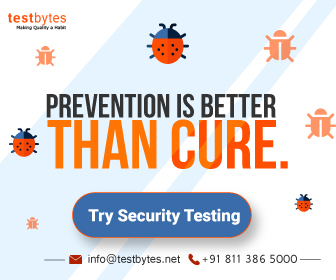Penetration Testing Certification is an added advantage for your current security testing job or if you wish to build a career in it. Security-related employment comprises many domains, for example, security analyst, information security specialist, security engineer, the system administrator (with security as a duty) network security administrator, and additionally specialized jobs, for example, penetration tester, intrusion analyst, and malware engineer. In this article, you will get to know about 10 Penetration Testing Certifications which are considered with high regard in the web-security industry.
What Are The Merits of Security Testing Certification?
- It comprehends vulnerabilities and risks influencing the companies once a day.
- Your misguided judgments about hacking will be solved as after the certification, you’ll get a general sense regarding what an ethical hacker’s role will be in the company.
- Additionally, you’ll comprehend that the idea of hacking is significantly more than just hacking into another person’s email or Facebook accounts.
- The program will prepare you for the enumeration and network scanning methods.
- Through the security testing program, you will learn different kinds of countermeasures, foot-printing, and foot-printing tools.
- You can likewise find what packet sniffing strategies are and how to secure against sniffing.
- You will build up your insight in the field of system hijacking and hacking techniques, steganography, virus analysis, covering tracks, the working of viruses, malware investigation strategy, and PC worms.
- As a white hacker certificate holder, you can likewise build up your expertise in Trojans, Trojan analysis, and Trojan countermeasures
- Lastly, you’ll figure out how the exploits develop.
So, in case you want to head towards the profession in the IT field and are interested in gaining practical experience in security testing, certification is an extraordinary decision.
It’s a powerful method to approve your abilities and demonstrate a current or prospective manager that you are qualified and appropriately trained.
Here is our list of 7 best security or penetration testing certification one must look forward to.
Top 20 Penetration testing certification
- Certified Ethical Hacker (CEH)
- Certified Information Systems Security Professional (CISSP)
- Certified Cloud Security Professional (CCSP)
- Offensive Security Certified Professional (OSCP)
- GIAC Security Essentials Certification
- Licensed Penetration Tester (LPT)
- CREST
- GIAC Exploit Researcher and Advanced Penetration tester
- (IACRB) Certified Penetration Tester
- Certified Red Team Operations Professional (CRTOP)
- Certified Ethical Hacker (CEH)
- Certified Information Systems Security Professional (CISSP)
- Certified Cloud Security Professional (CCSP)
- Offensive Security Certified Professional (OSCP)
- GIAC Security Essentials Certification
- Licensed Penetration Tester (LPT)
- CREST
- GIAC Exploit Researcher and Advanced Penetration tester
- (IACRB) Certified Penetration Tester
- Certified Red Team Operations Professional (CRTOP)
1. Certified Ethical Hacker (CEH)
The Certified Ethical Hacker is offered by the International Council of E-Commerce Consultants (EC-Council) which is an intermediate level qualification.
Know More: Salary of a Software Tester (2019)
It’s an unquestionable requirement have for IT experts seeking after a career in ethical hacking. It is considerably more technical certification.
The CEH certification sets up and oversees the base benchmarks for professional ethical hackers. The CEH certification affirms people in the particular system security control of ethical hacking.
CEH accreditation holders get learning and skills on hacking methods in fields, for example, scanning networks, foot-printing and reconnaissance, system hacking, enumeration, sniffers, Trojans, worms and viruses, social engineering, hacking web servers, session hijacking, wireless networks, and web applications, penetration testing, cryptography, SQL injection, avoiding IDS, honeypots, and firewalls.
Since innovation in the field of hacking transforms day by day, CEH certification holders are obligated to get 120 proceeding learning credits for every three-year cycle.
2. Certified Information Systems Security Professional (CISSP)
CISSP is an advanced level accreditation for IT masters who are serious about occupations in data security. This vendor-neutral accreditation is known as (ISC)2 and articulated as “ISC squared” offered by the International Information Systems Security Certification Consortium. It is perceived worldwide for its benchmarks of magnificence.
With the assistance of Certified Information Systems Security Professional aka CISSP program, the learner will get introduction towards the security solicitudes and can manage them in an expert way. The person will have the capacity to put the standard methods into usage.
On doing this course you will surely emerge and will be advantageous while going to attend interviews. The certification will also give a person an entrance to a system of industry and subject specialists who are into the security field.
3. Certified Cloud Security Professional (CCSP)
One of the primary purposes behind security experts to take the CCSP course is to demonstrate they are educated about cloud security as well as other security-related cloud contemplations – a situation at the front line of business advancement in IT.
Cloud environments are loaded up with security threats that differ day by day, so picking up the CCSP credential is imperative for proving to hiring managers you’re knowledgeable in the required security contemplations that are a vital part of cloud computing.
This course enables individuals to show capability in cloud data security, cloud design, and architecture, and also application security considerations, everyday activities, and considerably more. Any individual who is hoping to do a job in a cloud-based environment will be very much assisted with a CCSP certification.
4. Offensive Security Certified Professional (OSCP)
The Offensive Security Certified Professional is one of the most specialized programs of the certification choices. Offered by the revenue driven Offensive Security, it’s sponsored as the main totally hands-on accreditation program.
Offensive Security planned the course for technical experts to demonstrate they have a practical and reasonable comprehension of the penetration testing procedure and lifecycle.
Prior to opting for the OCSP course, comprehend that the coursework demands a strong technical comprehension of software development, systems networking protocols, and systems internals, particularly Kali Linux, an open-source venture by Offensive Security.
This is an online training course for most of the candidates as classroom training is just offered in Las Vegas.
The test-taker is assigned to recognizing vulnerabilities, researching the network, and hacking into the system to obtain official access within 24 hours.
Afterward, the Offensive Security certification commission should receive a thorough penetration test report for analysis and decide whether to award the certification.
5. GIAC Security Essentials Certification
The GIAC Security Essentials Certification is appropriate for people who are searching for employment growth in the cybersecurity domain. By doing this course, a person will have the capacity to prove capabilities to deal with security errands.
The people ought to be in charge of showing distinctive notions in the information security field. A person will have the potential to design and create a network architecture utilizing distinctive technologies, like NAC, VLAN’s, etc.
The program will also make the candidate skilled enough to run plenty of command-line tools to analyze the framework. The candidate will further gain pragmatic learning on windows security, threat management, Linux security, and so on.
6. Licensed Penetration Tester (LPT)
The LPT is the certification designed for the EC-Council’s whole data security track. It is a definitive trial of a person’s practical aptitudes as a penetration tester.
To acquire this certificate, you are asked to perform a full black-box penetration testing of a network given to you by the EC-Council. This implies following the whole procedure i.e. reconnaissance, enumeration, scanning, obtaining access, and managing access and afterward really employing vulnerabilities.
It is anyhow not an easy test. Regardless you should completely archive your activities in a total, proficient penetration test report. As your report will likewise be reviewed by other penetration testing experts that as of now have EC-Council’s LPT accreditation.
7. CREST
CREST data certificate courses and body’s pen test exams are broadly recognized around numerous countries.
This test certifies and teaches quality pen testers. The non-profit organization guides the necessities of a technical data security commercial center that involves the administration of an organized and regulated assistance industry.
CREST supports the top-notch capacity, ability, and consistency in the overall technical cybersecurity section.
With the goal to counter the danger of cyber-attack, it is trained candidates in a way that helps a business to work in an aggregate way and offer top practice and information.
8. GIAC Exploit Researcher and Advanced Penetration tester
Higher-level training programs meant for a person that has job duties such as assessment of the target network, finding vulnerabilities of system and application, etc.
Candidates should have the skill to conduct advanced penetration tests and should be able to think like an attacker and fin flaws in the system.
Requirements as per the website
- 1 proctored exam
- 55-75 questions
- A time limit of 3 hours
- Minimum Passing Score of 67%
The objective of the test include
- Must demonstrate how to bypass network access control systems
- Have to develop custom fuzzing test
- Must be able to write stack overflow exploits
- Find out common weakness in cryptographic implementations
- Must perform protocol fuzzing to trace out flaws
- Must show the basic understanding in X86 processor architecture, Linux memory management, assembly, and the linking and loading process.
- Have to showcase the ability in converting Python script and packet crafting using Scapy
- Have to express the ability in writing shellcode in Linux operating system
9. (IACRB) Certified Penetration Tester
The Information Assurance Certification Review Board (IACRB) offers a wide range of tests. CPT is one of the tests.
- An in-depth study about techniques used by black-hat hackers
- Current and up-to-date ethical hacking training
- Effective pen-testing methodologies
- Learn about network protocol attacks
- Learn about wireless security flaws
- Get to know about web-app flaws
- Know more about UNIX and Linux flaws
10. Certified Red Team Operations Professional (CRTOP)
Meant for people with expert-level knowledge and should perform a comprehensive assessment.
The two-hour exam will have a question from,
- Red team roles and responsibilities
- Red team assessment methodology
- Physical reconnaissance tools and techniques
- Digital reconnaissance tools and techniques
- Vulnerability identification and mapping
- Social engineering
- Red team assessment reporting
11. CompTIA PENTEST+
CompTIA PENTEST+ is an assessment consisting of 85 penetration testing questions which you have to answer in 165-minutes. This assessment requires a deep knowledge of penetration testing. The questions deal with security vulnerabilities in desktops, laptops, servers, mobile devices, and cloud environments. It also focuses on your practice skills that include analyses of Python and Bash code, vulnerabilities in apps and Bluetooth, etc.
12. CERTIFIED EXPERT PENETRATION TESTER (CEPT)
This certification includes a 2-hour assessment which has 50 multiple choice questions.wait deals with nine central subjects, but more important is the ingenuity of the applicants. The tester must have great attack simulations capabilities and should be able to find unknown cyber-weaknesses. Some of the topics you should be well versed with to take this certification are memory corruption, reverse engineering, and exploit creation in both for Linux and Window.
13. CERTIFIED PENETRATION TESTER (CPT)
To clear this certification the application must have deep knowledge of 9 bases of penetration testing, like exploits in Windows and Linux, penetration methodologies, wireless network security, and web application vulnerabilities. It is also a w hour assessment with 50 multiple-choice questions.
14. GIAC CERTIFIED INCIDENT HANDLER (GCIH)
This certification is a mix of multiple-choice and lab-based questions. There are over 100 questions to be covered in 4 hours. This assessment is a combination of penetration testing and security strategies. Some of the topics you must be well prepared with before taking this assessment are client attacks, denial-of-service attacks, and various attack modes. They should also know about various techniques and tools used by hackers. They should also know how to prevent these attacks.
15. GIAC ENTERPRISE VULNERABILITY ASSESSOR (GEVA)
This certification is mainly for those who want to get into cybersecurity for enterprise IT systems. It is a two-hour assessment with 75-question. Be prepared with topics like PowerShell scripting, network scanning, and vulnerability assessment frameworks. Applicants should also know how to resolve and report security issues.
16. GIAC ASSESSING AND AUDITING WIRELESS NETWORKS (GAWN)
This certification is a 2 hours test with 75 questions. The applicants must be proficient in detecting even the slightest gap in the security of the wireless network. They should be veterans in detecting and fighting against such attacks.
17. GIAC MOBILE DEVICE SECURITY ANALYST (GMOB)
This is a 75 questions assessment for 2 hours. The main topics it includes are tablet smartphone and app security. It requires the applicants to have knowledge of how hackers unlock mobile devices on different OS and they should also have knowledge on how to safeguard data on malware-infected devices.
18. GIAC WEB APPLICATION PENETRATION TESTER (GWAPT)
To clear this certification you should be proficient in dealing with the challenges of web apps. Basically have a clear understanding of topics like client injections, authentication attacks, cross-site request forgery, etc. It is a two-hour assessment having 75-question, which requires a deep understanding of possible attacks and penetration testing.
19. GIAC CERTIFIED PENETRATION TESTER (GPEN)
This certificate requires expertise in penetration testing, especially in its process. It is a 3-hour certification focusing on three main stages of exploit:
It also focuses on a few attack styles like web application injection attacks and password attacks. The assessment is a mix of 115 multiple choice or lab-based questions.
20. GIAC EXPLOIT RESEARCHER AND ADVANCED PENETRATION TESTER (GXPN)
It deals with advanced penetration testing techniques like exploiting stack overflows, think fuzzing, and shellcode scripting. The assessment is a 3-hour test including 75 multiple choice and lab questions. The main topics dealt with in this certification attacks on Linux and Windows and network exploits. It also assesses the tester’s capability to communicate their notions and findings to business stakeholders.
Conclusion
Becoming a valued certified ethical hacker or security tester is an incredible professional goal. Also, the demand for security testers surpasses the supply, this implies that salaries and perks are plentiful. All because nowadays everybody requires the administrations of an ethical hacker to test their frameworks.
Organizations hire security testers so they can record what was discovered and fix those vulnerabilities as quickly as they can for improving company’s security.

Also, as a certified ethical hacker, you can give individual assistance to people in recovering email, documents, and data that might be unavailable due to any kind of issues.
Thus, above-mentioned security testing courses are the most sought-after certifications available today to make a fantastic career in the domain of security testing.
Know More: Salary of a Developer vs Tester? Who Earns more!


















